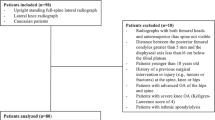Abstract
Purpose
Greater trochanteric pain syndrome (GTPS) is a condition resulting in lateral hip pain, most commonly caused by tendinosis or tear of the gluteus medius and minimus tendons, and greater trochanteric bursitis. Our aim was to assess pelvic parameters and proximal femoral anatomy in patients suffering from surgical-stage GTPS compared with a control group.
Methods
This retrospective, case-control study assessed 43 patients suffering from GTPS, matched according to age, gender, body mass index and level of sport and physical activity to 43 control patients, between 2013 and 2018. Pelvic parameters, including pelvic incidence (PI), pelvic tilt (PT) and sacral slope (SS), and proximal femoral anatomy, including femoral offset (FO) and neck-shaft angle (NSA), were measured using the EOS Imaging™ system.
Results
GTPS patients had a significantly lower mean (± SD) SS than control patients (33.1 ± 10.4 vs. 39.6 ± 9.7°, respectively; p < 0.05). There was no significant difference in PT (21.3 ± 7.1 vs. 19.0 ± 7.2°), PI (53.5 ± 11.6 vs. 57.7 ± 10.5°), FO (40.4 ± 8 vs. 42.2 ± 6.8°) or NSA (125.1 ± 5.8 vs. 124.4 ± 4.7°). There was no difference in lower back pain symptoms in a subgroup analysis of GTPS patients.
Conclusions
Sacral slope was lower in patients with surgical-stage GTPS than in asymptomatic hip patients, using the EOS Imaging™ system.




Similar content being viewed by others
Abbreviations
- GTPS:
-
Greater trochanteric pain syndrome
- GT:
-
Greater trochanter
- MRI:
-
Magnetic resonance imaging
- BMI:
-
Body mass index
- UCLA:
-
University of California, Los Angeles
- LBP:
-
Lower back pain
- PI:
-
Pelvic incidence
- PT:
-
Pelvic tilt
- SS:
-
Sacral slope
- FO:
-
Femoral offset
- NSA:
-
Neck-shaft angle
References
Dunn T, Heller CA, McCarthy SW, Dos Remedios C. Anatomical study of the ‘trochanteric bursa’. Clin Anat. 2003;16:233–40.
Board TN, Hughes SJ, Freemont AJ. Trochanteric bursitis: the last great misnomer. Hip Int. 2014;24:610–5.
Williams BS, Cohen SP. Greater trochanteric pain syndrome: a review of anatomy, diagnosis and treatment. Anesth Analg. 2009;108:1662–70.
Torres A, Fernández-Fairen M, Sueiro-Fernández J. Greater trochanteric pain syndrome and gluteus medius and minimus tendinosis: nonsurgical treatment. Pain Manag. 2018;8:45–55.
Blankenbaker DG, et al. Correlation of MRI findings with clinical findings of trochanteric pain syndrome. Skeletal Radiol. 2008;37:903–9.
Segal NA, et al. Greater trochanteric pain syndrome: epidemiology and associated factors. Arch Phys Med Rehabil. 2007;88:988–92.
Sayegh F, Potoupnis M, Kapetanos G. Greater trochanter bursitis pain syndrome in females with chronic low back pain and sciatica. Acta Orthop Belg. 2004;70:423–8.
Collée G, Dijkmans BA, Vandenbroucke JP, Cats A. Greater trochanteric pain syndrome (trochanteric bursitis) in low back pain. Scand J Rheumatol. 1991;20:262–6.
Laird RA, Gilbert J, Kent P, Keating JL. Comparing lumbo-pelvic kinematics in people with and without back pain: a systematic review and meta-analysis. BMC Musculoskelet Disord. 2014;15:229.
Chaléat-Valayer E, et al. Sagittal spino-pelvic alignment in chronic low back pain. Eur Spine J. 2011;20:634–40.
Rajnics P, Templier A, Skalli W, Lavaste F, Illes T. The importance of spinopelvic parameters in patients with lumbar disc lesions. Int Orthop. 2002;26:104–8.
Barratt PA, Brookes N, Newson A. Conservative treatments for greater trochanteric pain syndrome: a systematic review. Br J Sports Med. 2017;51:97–104.
Thaunat M, et al. Endoscopic management of gluteus medius tendon tears. Sports Med Arthrosc Rev. 2016;24:11–8.
Dubousset J, et al. A new 2D and 3D imaging approach to musculoskeletal physiology and pathology with low-dose radiation and the standing position: the EOS system. Bull Acad Natl Med. 2005;189:287–97; discussion 297–300.
Morvan G, et al. Standardized way for imaging of the sagittal spinal balance. Eur Spine J. 2011;20(Suppl 5):602–8.
Somoskeöy S, Tunyogi-Csapó M, Bogyó C, Illés T. Accuracy and reliability of coronal and sagittal spinal curvature data based on patient-specific three-dimensional models created by the EOS 2D/3D imaging system. Spine J. 2012;12:1052–9.
Redmond JM, Chen AW, Domb BG. Greater trochanteric pain syndrome. J Am Acad Orthop Surg. 2016;24:231–40.
Noshchenko A, Hoffecker L, Cain CMJ, Patel VV, Burger EL. Spinopelvic parameters in asymptomatic subjects without spine disease and deformity: a systematic review with meta-analysis. Clin Spine Surg. 2017;30:392–403.
Lecerf G, et al. Femoral offset: anatomical concept, definition, assessment, implications for preoperative templating and hip arthroplasty. Orthop Traumatol Surg Res. 2009;95:210–9.
Boese CK, et al. The femoral neck-shaft angle on plain radiographs: a systematic review. Skelet Radiol. 2016;45:19–28.
Roussouly P, Pinheiro-Franco JL. Biomechanical analysis of the spino-pelvic organization and adaptation in pathology. Eur Spine J. 2011;20:609–18.
Barrey C, Jund J, Noseda O, Roussouly P. Sagittal balance of the pelvis-spine complex and lumbar degenerative diseases. A comparative study about 85 cases. Eur Spine J. 2007;16:1459–67.
Jang J-S, Lee S-H, Min J-H, Maeng DH. Changes in sagittal alignment after restoration of lower lumbar lordosis in patients with degenerative flat back syndrome. J Neurosurg Spine. 2007;7:387–92.
Le Huec JC, Hasegawa K. Normative values for the spine shape parameters using 3D standing analysis from a database of 268 asymptomatic Caucasian and Japanese subjects. Eur Spine J. 2016;25:3630–7.
Roussouly P, Berthonnaud E, Dimnet J. Geometrical and mechanical analysis of lumbar lordosis in an asymptomatic population: proposed classification. Rev Chir Orthop Reparatrice Appar Mot. 2003;89:632–9.
Saltzman BM, et al. Assessment of association between Spino-pelvic parameters and outcomes following gluteus medius repair. Arthroscopy. 2016;35:1092–1098.
Author information
Authors and Affiliations
Corresponding author
Ethics declarations
Conflict of interest
Mathieu Thaunat is consultant for Arthrex Company. All other authors declare that they have no conflict of interest.
Additional information
Publisher’s note
Springer Nature remains neutral with regard to jurisdictional claims in published maps and institutional affiliations.
Rights and permissions
About this article
Cite this article
Canetti, R., de Saint Vincent, B., Vieira, T.D. et al. Spinopelvic parameters in greater trochanteric pain syndrome: a retrospective case-control study. Skeletal Radiol 49, 773–778 (2020). https://doi.org/10.1007/s00256-019-03359-x
Received:
Revised:
Accepted:
Published:
Issue Date:
DOI: https://doi.org/10.1007/s00256-019-03359-x




